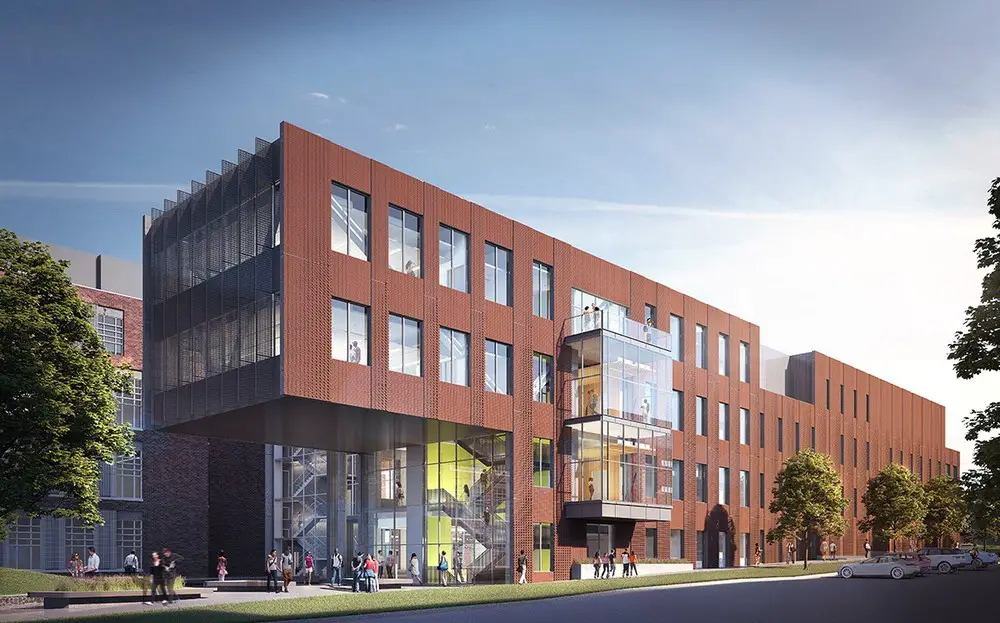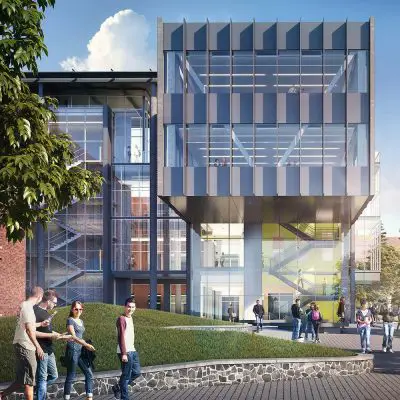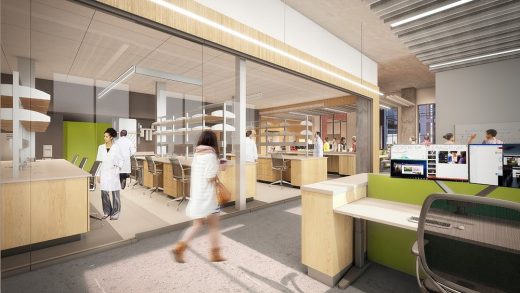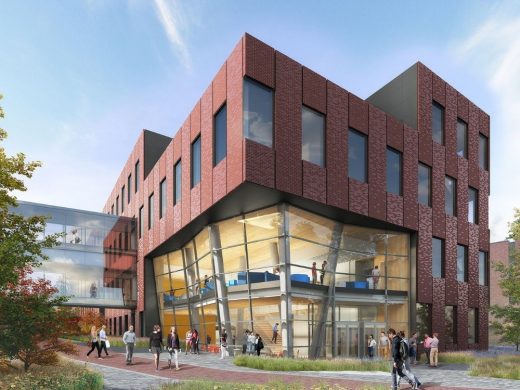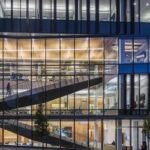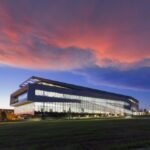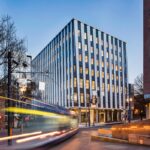Two New Science Laboratories Cheney WA, North American Modern Campus Buildings, US Architecture Projects
Two New Science Laboratories in Washington
Washington Campus Buildings, North America design by LMN architects, WA, USA
post updated March 17, 2024
Architects: LMN
Location: Cheney, Washington, USA
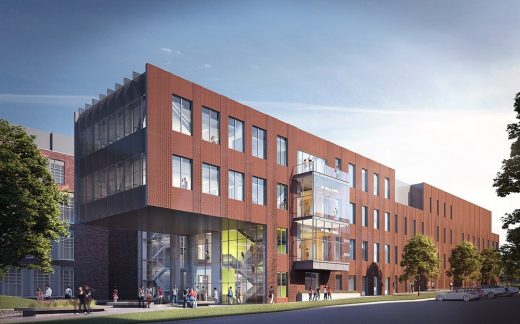
images courtesy of architects practice
Dec 11, 2019
Two New Science Laboratories, WA
LMN Architects is pleased to celebrate the design and construction of Two New Science Laboratories at Washington State University in Pullman, and Eastern Washington University in Cheney. Located at the center of each development, the new laboratories have unique social spaces with welcoming environments for a discipline that has traditionally been on the periphery of each campus.
Washington State University is a preeminent agricultural research institution committed to fostering its land-grant heritage and tradition of service to society. The Plant Sciences Building integrates several disciplines from the College of Agricultural, Human & Natural Resource Sciences and is central to fulfilling this mission.
The building scheduled to be completed in October is the new center for interdisciplinary research and is being designed and constructed by the design/build team of Skanska and LMN Architects. The project provides new infrastructure for the Institute of Biological Chemistry, as well as laboratories that integrate faculty and students in plant biochemistry, pathology, horticulture, and crop and soil sciences into a single state-of-the-art facility.
“The Plant Sciences Building represents a major investment in Washington State’s commitment to sustainable agriculture and ecological stewardship” says LMN Partner Stephen Van Dyck, AIA. “Through our planning and design collaboration with Washington State University, we’ve envisioned a new state-of-the-art research facility that will both foster innovation in this critical sector and nurture a collaborative culture within the research campus.”
The new 82,000 gross square foot building is the fourth to be completed within the master plan for the Research and Education Complex (REC) at WSU, originally developed by LMN Architects in 2005. The master plan envisioned a series of laboratory buildings alternately flanking a glazed spine element that serves as the connective tissue for the social and research life of the complex.
The new building is positioned to the north of the Food Science and Human Nutrition Building and to the south of the Biotechnology and Life Sciences building, also designed by LMN Architects and completed in 2009. In its central location, the building also forms a prominent west-facing entry point to the completed complex.
The efficient plan arrangement of the L-shaped building allows it to fulfill the master plan while accommodating an existing utility tunnel to the south. The building’s cantilevered composition frames a new grand entry to the whole complex and features a two-floor cantilever facing west towards Martin Stadium. The new landscaped approach creates a multifunctional public space for the university, celebrating arrival to the complex and fostering campus-wide gatherings.
The new facility will be a social and interdisciplinary heart for the research complex. Designed for flexibility well into the future, the building hosts infrastructure for a variety of research needs beyond the College of Agriculture, Human and Natural Resource Sciences.
Upon arrival, a welcoming four-floor staircase encourages vertical circulation and provides important visual connections between floors. At every level, centralized social spaces link circulation elements with the REC’s central spine, designed to fuel spontaneous collaboration within the communal core.
The interior arrangement of laboratories is designed to support efficient and flexible research over time. The modular laboratories can be easily rearranged to respond to the changing needs of research throughout the building. To the north of the modular laboratories, offices for Principal Investigators are interspersed with open work areas for graduate researchers. To the south of the laboratories, a series of modular support spaces accommodate a variety of specialized research equipment within easy reach of the adjacent lab benches.
On the exterior, the building reimagines the red-brick campus vernacular in a new architectural approach; a high-performance precast concrete façade panel system is clad with a sculpted, red-brick veneer. The panels integrate structure, insulation, weather barrier, interior and exterior finishes within a single prefabricated component, accelerating construction sequencing and enabling a bespoke composition of organically inspired brick surfacing.
The resulting building form presents an abstract composition resulting in the integration of the building’s internal modular planning with the panelized façade components.
“Together with Skanska and Washington State University, we have approached the delivery process as an effort in applied research” says Van Dyck. “Our Progressive Design-Build team has pursued innovative design and construction methods throughout our process from day one, allowing us to explore new opportunities for architectural and material expression while maximizing efficiencies at the same time.”
The integrated façade system both enhances the speed of the construction schedule and transforms the architectural possibilities throughout the building. On the inside, the concrete panels are left exposed to become the finished surface in many of the building’s workspaces. On the exterior, the undulating brick pattern—made possible through bespoke, CNC-driven formwork—casts shadows which animate the façade throughout the day in a dynamic play of light that is unique to the eastern Washington Palouse landscape.
The new Interdisciplinary Science Center for physics, chemistry, biology, and geology at Eastern Washington University places science prominently within the public life of the University. The 102,000 gross square foot facility is connected to the existing Science Building Center by two enclosed pedestrian bridges, forming a single integrated facility between the two structures.
The building design also completes the western edge of Arevalo Student Mall and to the south, it accommodates and amplifies a primary pedestrian corridor, connecting the central campus to the growing athletics precinct to the west. Along this pathway, the building and its bridges frame a significant new campus gateway moment that will reinforce the prominence of the Sciences at Eastern Washington University.
“The Interdisciplinary Science Center is designed to enmesh the Sciences within the core of the Eastern campus” says LMN Partner Stephen Van Dyck, AIA. “The project elevates the expectations of architecture and landscape to actively contribute to the pedagogical life of the building. Through our close working relationship with several faculty members during the design process, we were able to transform the project into a teaching tool itself.”
Two New Science Laboratories at Washington State University in Pullman, and Eastern Washington University in Cheney:
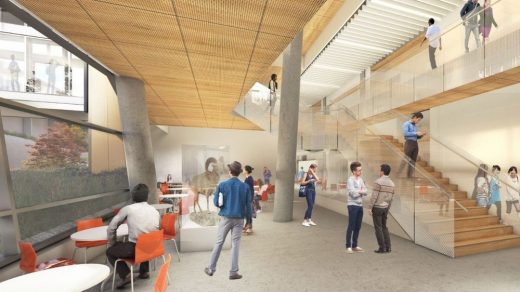
Inside the building, laboratory instrument exhibits and educational displays are integrated along its central corridor walls, creating an interactive educational environment and connecting laboratory and corridor in a dynamic exchange of filtered views. Outside the building, the landscape design was crafted in close collaboration between the design team and teaching faculty, and it features significant local geologic specimens along site walls and native plant species arrayed among the building’s various micro-climates.
The architectural composition presents a four-level brick clad rectangular form with prominent voids at either end. Within each void, a crystalline glass wall marks major entries and social spaces. “The building is designed to be both symbolic and intuitive” says Van Dyck. “The logic of the panelized brick enclosure gives way to the unexpected. These moments of punctuation and pause frame the spaces where people will come together, connecting the activity of the building within to the campus beyond.”
The dominant rectangular form of the building is clad with a panelized red brick façade system, alternately staggered in elevation to reveal a consistent rhythm of windows into the laboratory spaces within. The envelope system is detailed with a purity and simplicity to match the building’s composition, with black metal trim elements simplifying the joints between panels and windows. The planar brick panels are accentuated with a subtle mix of cascading glazed surfaces, animating the façade in a continual play of subtle reflection throughout the day.
Two New Science Laboratories at Washington State University, Pullman & Eastern Washington University, Cheney, WA, USA:
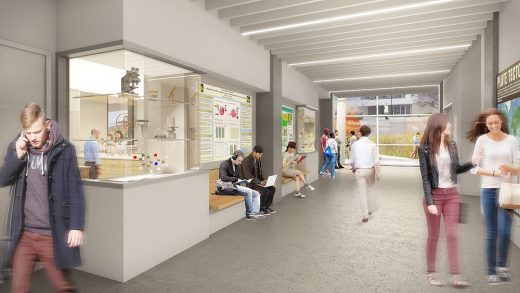
The internal organization of the building follows the linear movement through the site, with laboratories flanking either side of a generous central corridor on all floors. The building responds to the site topography through its internal circulation and features a prominent stair at the eastern entry that leads to the second level corridor and western entry beyond. A lecture hall at level 1 is carved into the sloping site and forms the terminus of that level in the hillside.
The three levels above feature a linear arrangement of laboratories, each with a corner display window that visually connects the teaching spaces to the social life of the building. Laboratories are tailored to the unique needs and special requirements of each department and are interconnected along the exterior edge of the building via a “ghost” corridor to adjacent prep rooms. A multipurpose gathering space on the fourth floor is accentuated with faceted glass walls facing south and east and features an adjacent terrace with views over the campus to the landscape and mountains beyond.
Sustainable strategies include low-flow fume hoods and heat recovery pipes, rainwater harvesting, xeriscaping and inclusion of botanical and geological landscape elements that serve as teaching tools. The building is scheduled to be completed in the Fall and is targeting LEED Gold certification.
Each laboratory is a complex yet simple composition of private and public spaces that elevate the social experience. The buildings are in dialogue with the academic context, and each design is a highly ordered study in scale, materiality, transparency and natural light with various degrees of privacy for faculty and students. LMN Architects is a leader in the design of higher education facilities across the United States.
Other completed projects include the Bill & Melinda Gates Center for Computer Science & Engineering at the University of Washington; the Voxman Music Building at the University of Iowa in Iowa City; the Anteater Learning Pavilion at the University of California, Irvine; and the Huntsman School of Business Addition at Utah State University in Logan, Utah.
Two New Science Laboratories, Washington State University – Building Information
Architects: LMN
Project Title: Plant Sciences Building
Location: Washington State University, Pullman, Washington, USA
Client: Washington State University.
Design Years: 2017-2018
Construction Years: 2018-2020
Major Building Materials: Precast Concrete Panels with Brick Veneer, Curtainwall, and Composite Metal Panel.
Program: Wet Research Labs and Support Labs, Dry Research Labs, PI Offices, Growth Facility, MMPL Core Lab, 3 Meeting Rooms, 1 Large Conference, breakout collaboration and shared break room at each level, and Administrative Office Suite.
Site Area: 133,775 SFT
Floor Area: 80,300 SFT
Building Height: 84 FT
Number of floors: 5
Project Credits
Architect: LMN Architects
Project Team: Dean Clark, AIA
Clint Cook, AIA
Stephen Van Dyck, AIA
Melissa Eby
Tiffani Erdmanczyk
Chuoc Lam, AIA
Evan McQuillen, Assoc. AIA
Jennifer Milliron, Assoc. AIA
George Shaw, FAIA
Sunmin Whang, AIA
Civil Engineer: Coughlin Porter Lundeen, Inc.
Contractor & Construction Manager: Skanska USA Building
Landscape Architect: Berger Partnership
Lighting Design: MW Consulting Engineers
MEP Engineer: MW Consulting Engineers
Structural Engineer: Magnusson Klemencic Associates
Project Title: Interdisciplinary Science Center
Location: Eastern Washington University, Cheney, Washington.
Client: Eastern Washington University.
Design Years: 2016-2017
Construction Years: 2018-2020
Major Building Materials: Brick, Curtainwall, and Composite Metal Panel
Program: Teaching Laboratories, Laboratory Support, 100-seat Classroom and Prefunction Space, Lobby, Lounge, Seminar Room, Study Spaces, and Technician Offices.
Site Area: 97,500 SFT
Floor Area: 102,700 SFT
Building Height: 66 FT
Number of floors: 4
Project Credits
Architect: LMN Architects
Project Team:
Kjell Anderson, AIA
Greg Bishop, AIA
Dean Clark, AIA
Sara Clinch
Steve DelFraino, AIA
Stephen Van Dyck, AIA
Matthew Fisher, AIA
Tanner Kirchoff, AIA
Sam Miller, FAIA
Jennifer Milliron, Assoc. AIA
Erik Perka, Assoc. AIA
Julia Reeve, AIA
Civil Engineer: Coughlin Porter Lundeen, Inc.
Contractor & Construction Manager: Lydig Construction
Landscape Architect: Berger Partnership
Lighting Design: MW Consulting Engineers
MEP Engineer: MW Consulting Engineers
Laboratory Planning Consultant: Research Facilities Design
Structural Engineer: Magnusson Klemencic Associates
Two New Science Laboratories for Washington State University images / information received 111219 from LMN architects
Location: Cheney, Washington, USA
Washington Architecture
Washington Architectural Projects
Design: LMN Architects
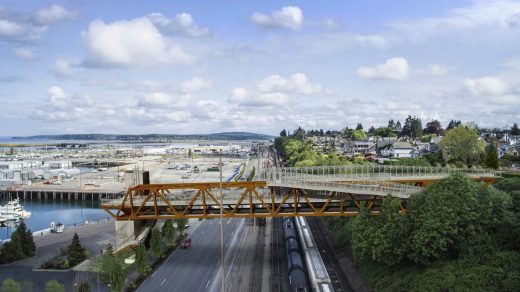
Construction Photography Credit: Adam Hunter/LMN Architects
Everett Grand Avenue Pedestrian Bridge
Architects: Prentiss + Balance + Wickline
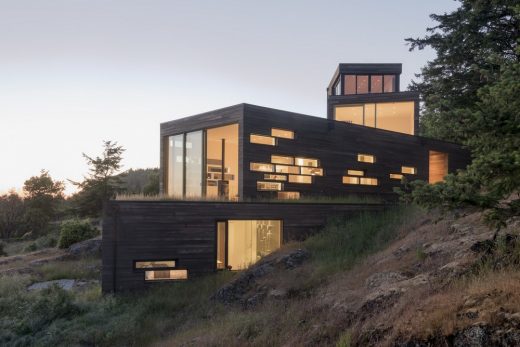
photography : Eirik Johnson
Residence at Friday Harbor
American Architecture Links – chronological list
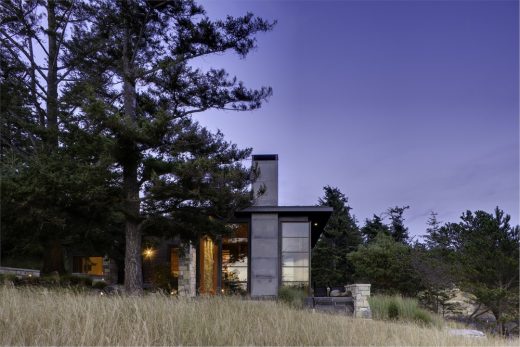
photograph : Jay Goodrich
House on San Juan Island
Washington State University Visitor Center
American Architecture Designs
American Architectural Designs – recent selection from e-architect:
Comments / photos for the Two New Science Laboratories for Washington State University design by LMN architects page welcome.

